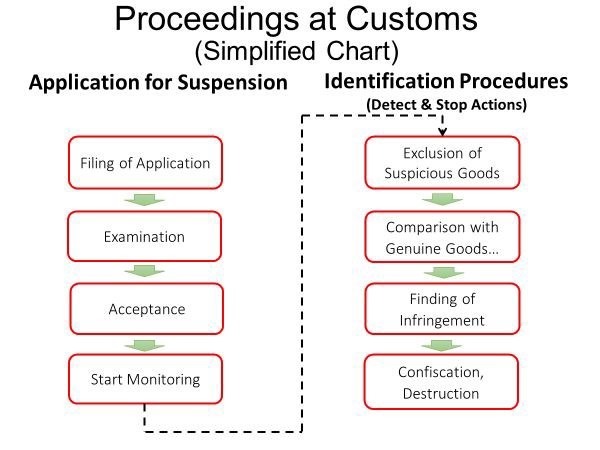2019.12.24
Border Enforcement in Japan
TRADEMARK
Border Enforcement in Japan
1. INTRODUCTION
We sometimes see counterfeit goods in Japan. Unfortunately, famous brands in particular tend to be targeted. Supposing that there is a case of importation into and sale in Japan of goods which can be regarded as counterfeit products, an administrative remedy may be applied, i.e., seizure of infringing goods at the point of importation by Customs, as well as criminal or civil proceedings as the case may be. Below is a summary of a legal remedy to prevent importation of counterfeit goods into Japan, i.e., border enforcement at Customs.
Please note that, depending on the circumstances, it is possible to make claims on the basis of trademark infringement and/or the Unfair Competition Prevention Law. It should be noted, however, that since an action based on the Unfair Competition Prevention Law is much more difficult to establish, the focus here is on trademark infringement claims.
2. PROCEEDINGS AT CUSTOMS
(1) OVERVIEW
This approach basically involves the recordal at Japan Customs.

One of the main advantages of this option is that it targets the infringing goods themselves without necessarily making a reference to the identity of the source or the importer of the goods. This has obvious benefits over an actual lawsuit, wherein the plaintiff must designate a particular defendant, and the remedy ultimately obtained (such as injunction) is useless to prevent the importation or sale of goods by another party, since it is only valid with respect to the named defendant. In situations such as counterfeit goods importation, where the goods in question may be sold by many different parties, a kind of blanket prohibition on the importation of the goods, regardless of which party has imported or sold them, is far preferable to a remedy obtained by an ordinary lawsuit.
Other advantages are that (i) it is relatively quick to obtain the desired cessation of importation as compared with lawsuits, assuming Customs can be provided with enough information, and (ii) since the matter is mainly dealt with by Customs officials, the costs involved in obtaining a prohibition on importation are minimal.
On the other hand, a disadvantage, as compared with a lawsuit, is that it offers no prospect for obtaining compensation or indemnification in respect of the losses suffered. However, if the ultimate concern is to prevent importation quickly and effectively, this is recommended.
Also, the important point to note is that the availability of as much detailed information as possible will obviously speed up the action of Customs. Indeed, Customs' speed and intensity of investigation will largely depend on how far and fast they can be provided with such information as the country of origin, manufacturer, importer and exporter of the goods in question, as well as their quality, characteristics and so on.
(2) APPLICATION FOR SUSPENSION
To enjoy the above benefits, it is necessary to make a request for the recordal at Customs ("Application for Suspension"). The required documents are: (1) An application form; (2) A transcript of the Trademark Registry and the Trademark Bulletin; (3) Prima facie evidence of the infringement of trademark right, such as samples, pictures, etc.; (4) Documents detailing how to distinguish infringing goods from genuine goods; and (5) A power of attorney. The critical points may be the documents (3) and (4). In Japan, it is necessary to show that there are already trademark infringing goods. Also, in practice, Customs strongly recommends that we should consult with them before officially filing the "Application for Suspension."
The recordal at Customs is valid for 4 years and can be renewed every 4 years. It should be noted, however, that if the expiry date of the trademark registration at the JPO comes before the expiry date of the recordal at Customs, the period of the validity or renewal term will end at the expiry date of the trademark registration at the JPO.
(3) IDENTIFICATION PROCEDURES
If Customs detects suspicious goods, the case will move to "Identification Procedures." Customs will generally inform the trademark owner and the importer and detain the goods in question for 10-working days. If there are objections from the importer during this period, the detaining time may be longer, i.e., about 2 to 3 months. Also, a security deposit may be required at the time the cessation of importation is granted. If Customs eventually finds the goods in question as trademark infringement, they will confiscate or destroy them at no charge.
3. CONCLUSION
I hope the above information will be of help to understand the Japanese practice of the border enforcement at Customs. If you have any further questions or need any additional information, please feel free to contact us.
